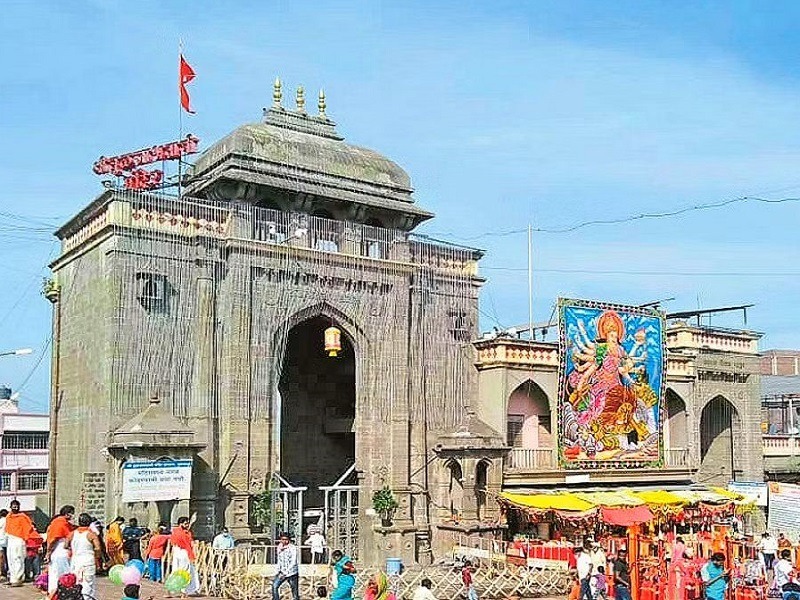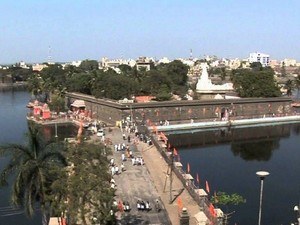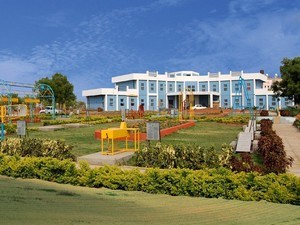Tuljapur Sri Bhavani Temple, Solapur - Timings, Festivals, History, Darshan, Pooja Timings
Photo Credit: Flickr
 India | Maharashtra | Solapur
India | Maharashtra | Solapur
 #6 of 8 Places to Visit in Solapur
#6 of 8 Places to Visit in Solapur
 Distance (From Solapur): 39 Kms
Distance (From Solapur): 39 Kms
 Trip Duration (Including Travel): 3-4 Hours
Trip Duration (Including Travel): 3-4 Hours
 Place Location: At Tuljapur
Place Location: At Tuljapur
 Transportation Options: Bus / Cab
Transportation Options: Bus / Cab
 Travel Tips: None
Travel Tips: None
About Tuljapur Sri Bhavani Temple
At a distance of 39 Km from Akkalkot, and 46 Km from Solapur, Sri Tulja Bhavani Temple is a Hindu temple located in Tuljapur in the Dharashiv district of Maharashtra, India. The temple is dedicated to goddess Bhavani, literally translates to 'giver of life',is considered to be a mother who provides to her devotees and also plays the role of dispensing justice by killing Asuras. Sri Tulja Bhavani Temple is considered as one of the 51 Shakti Pithas in India. Besides, the temple of Bhavani at Tuljapur along with the temples of Renuka at Mahur, Mahalaxmi at Kolhapur, and Saptashringi at Vani forms the four great Shaktipithas in Maharashtra.It is one of the top places of pilgrimage in Maharashtra, and among the prominent places to visit near Hyderabad.
History of Tuljapur Sri Bhavani Temple
Tuljapur Sri Bhavani Temple was established in the 12th century CE by Maratha Mahamandaleshwara Maradadeva of the Kadamba dynasty. This temple is of significant importance to the Maratha Empire, representing their pride and valor. It is also closely linked to the Bhonsle dynasty, known for their deep devotion to Goddess Tulja Bhavani. Chhatrapati Shivaji, the founder of the Maratha kingdom, is said to have frequently visited this temple to receive blessings. Legend has it that Goddess Bhavani bestowed upon him the 'Bhavani sword,' which contributed to his success in various military campaigns.
Mythology of Tuljapur Sri Bhavani Temple
The origins of the temple can be traced back to the era of the 'Skanda Purana,' where it is referenced in this sacred text. According to legend, a sage named Kardam resided in this region with his wife, Anubhuthi, and their infant child. Following his passing, Anubhuthi undertook a penance dedicated to Goddess Bhavani along the banks of the Mandakini River to seek protection for her child. During her meditation, a demon named Kukur attempted to disrupt her efforts, prompting the Goddess to intervene and vanquish the demon. At the request of her devoted follower, the Goddess chose to reside on the hill of Bala Ghat. Consequently, she became known as Bhavani of Tuljapur, or Tulja Bhavani. The Bhavani temple is also significant as the site where Shivaji I, the founder of the Maratha Empire, received blessings from the Goddess.
Architecture of Sri Tuljapur Sri Bhavani Temple
The Sri Tulja Bhavani Temple exemplifies a harmonious fusion of Hemadpanthi and traditional Indian architectural styles. The primary entrance is named after Sardar Nimbalkar, while the other two entrances honor the parents of Chhatrapati Shivaji, Shahaji and Jijabai. Upon entering through the Sardar Nimbalkar entrance, visitors will find a temple dedicated to Markandeya Rishi on the right side. Descending the stairs leads to the main Tulja Bhavani Temple, where the sanctum enshrines the idol of Goddess Bhavani, believed to be swayambhu. This three-foot tall idol features eight arms wielding weapons and displays the head of the vanquished demon Mahishasura. The Goddess is also referred to as Tulaja, Turaja, Tvarita, and Amba.
In front of the temple lies a yagna kund (holy fire pit). Additionally, there are sacred ponds known as Gomukh Theerth and Kallol Theerth, where devotees immerse themselves before entering the sanctum sanctorum of the Goddess. The premises also include Amruth Kund and a Datta temple, along with shrines dedicated to Siddhi Vinayak, Aadishakti, Aadimata Matangadevi, and Goddess Annapurna. The walls and ceilings of the temple are adorned with exquisite paintings that illustrate scenes from everyday life and legends related to the goddess. Situated on a hillock, the temple provides breathtaking views of the surrounding landscape.
Festivals of Tuljapur Sri Bhavani Temple
The Tuljapur Bhavani Temple is renowned for its celebration of several key festivals, including the Tulja Bhavani Festival, Ganesh Chaturthi, Diwali, and Holi. Among these, the Tulja Bhavani Festival, which takes place during Navratri, holds particular importance and is celebrated biannually. This festival represents the strength of femininity and the triumph of good over evil.
Tuljapur Sri Bhavani Temple Dress Code & Other Restrictions
Although the Tulja Bhavani Temple does not enforce a strict dress code, it is advisable to wear modest attire that covers the upper arms and legs as a mark of respect. Men are encouraged to don a dhoti or pajama along with an upper garment, or alternatively, formal trousers and shirts. Women may choose to wear a saree, half saree, or chudidhars. It is recommended to avoid modern clothing such as mini-skirts, shorts, and sleeveless tops while visiting the temple.
Non-Hindus are generally allowed in the Bhavani Temple. The temple is open to visitors of all backgrounds seeking spiritual guidance and reflection.
Tuljapur Sri Bhavani Temple Timings
Monday: 5 AM - 11:30 AM & 12:30 PM - 9 PM
Tuesday: 5 AM - 11:30 AM & 12:30 PM - 9 PM
Wednesday: 5 AM - 11:30 AM & 12:30 PM - 9 PM
Thursday: 5 AM - 11:30 AM & 12:30 PM - 9 PM
Friday: 5 AM - 11:30 AM & 12:30 PM - 9 PM
Saturday: 5 AM - 11:30 AM & 12:30 PM - 9 PM
Sunday: 5 AM - 11:30 AM & 12:30 PM - 9 PM
Tuljapur Sri Bhavani Temple Entry Fee
General Entry is Free
Special Darshan available for Rs. 200
VIP Darshan available for Rs. 300
Best Time to Visit Tuljapur Sri Bhavani Temple
The optimal time to visit the Tuljapur Temple is from October to March, as the weather during these months is enjoyable and suitable for temple excursions. For those wishing to experience the temple at its most spiritually vibrant, it is advisable to plan your visit during Ganesha Chaturthi and the Tuljapur Bhavani Festival. During these events, thousands of devotees gather, engaging in bhajans and dancing in devotion, which creates a lively and electrifying atmosphere. Additionally, the monsoon season provides a refreshing environment, as the rainfall helps to cool the temperatures. In contrast, summer is characterized by high humidity and elevated temperatures, making it a less desirable time for temple visits.
How to Reach Tuljapur Sri Bhavani Temple
The closest airport to Sri Tulja Bhavani Temple in Tuljapur is Solapur Airport, situated around 52 kilometers away, although it offers limited flight services. For better connectivity, the nearest major airport is Pune International Airport, which is approximately 297 kilometers from Tuljapur. The nearest railway station is Solapur Railway Station, located about 46 kilometers away, providing good rail connections to cities such as Mumbai, Pune, Hyderabad, and Bengaluru. Travelers can hire a taxi or take a bus from Solapur to reach Tuljapur. Additionally, Sri Tulja Bhavani Temple is easily accessible by road from major cities including Solapur, Osmanabad, Pune, and Aurangabad.















